Discontents: 1. Natural Grocers FTW. 2. Tunes. 3. Forbes: Price Gouging.
Note to readers, especially paid subscribers: Thank you for reading, tuning in, sharing, commenting, arguing and considering these updates. They are fun to do. We spend a lot of time being critical of what we need to change in the grocery industry, but we also should lift up what is being done well. While the Kroger FTC trial and price gouging discussion is grabbing headlines and Walmart’s massive growth is absorbing ever more market share, we will give them plenty of column space, but maybe not so much this week. We instead turn our intention to a more quirky, but compelling topic.
1. Natural Grocers For The Win
She greets you like she knows your name.
Grandma Isely. Kind but tired eyes, pleasant smile, ruffled white collar on a black blouse. Like your third grade teacher, reminding you to do your homework, or eat your vegetables. She presents the five founding principles upon entry, so you know what to expect, how to grade your experience here. Nutrition education, quality, affordability, community and employees. At once idealistic, prosaic and yet, common sense. Of course, this is always how it should be. For everyone.
The smell. Nostalgic, like the warm, herbaceous, still-baked as fuck-seventies never smelted into volatile eighties plasticity or nineties grunge nihilism. Small format store, my favorite type. Like Mom’s back east. Or my co-op. I won’t get lost in here or waste half an afternoon scouring the shelves for 5 things. In and out and done.
The hours are odd, 8:27 AM-8:36 PM most days, shaving 90 minutes on Sunday 8:57 AM-7:36 PM. “We will let you in when you come early. We won’t kick you out when you dawdle” is how to read that. Kindness, or just best in class customer service.
Produce, all organic. 100%.
No signs extolling localism. No farmer pictures, no greenwash or local-wash, just a straightforward message on a small, tightly packed and clean leafy greens and fruit display. Apples, berries, peaches when in season, bushy kales, lettuce, hairy beets and bags of carrots. Covering all the basics, nothing spectacular. Nothing iconic or innovative, not always the freshest or most beautiful, just good organic produce. Albert’s and UNFI’s best, hopefully shipped from a nearby distribution center after overland trucking from the organic production belts of California, Oregon, Washington, southeastern Pennsylvania and southern Florida. Virtually free of glyphosate and paraquat and permethrin and 2,4-D and dicamba and a thousand other highly volatile agrichemicals linked to cancer, Parkinson’s, hormone disruption, neurological issues, inflammation and who the fuck knows what else. Free of the sprays and residues that are usually found in totally normal, conventional, every day produce because organic is the weird one here in our upside down and backwards food system. But 100%, all organic, that is a nice to have. PCC in Seattle, a close second at 98% or so. Whole Foods, only 54%. Trader Joe’s, do they even sell produce? Costco, hit or miss. Kroger, who knows. Walmart, well, lol.
Around the corner is a throwback, an anachronism to the pre-plastic days, before Nestle and Coca-Cola and Pepsi started stealing municipal tap water for mass bottled consumption. From before the great Pacific plastic trash island vortex. A real water machine. Like a living mechanized fossil. Bring your own bottles, or buy a big blue jug, BPA free of course. Reverse osmosis, the only time you will ever say osmosis outside of a 9th grade biology course. Particle prefiltration, carbon prefiltration, post carbon filtration, ultraviolet sterilization- that is some hardcore water. Nothing is getting through that water filter, no chloramine, no sewage particles, no fish farts, no zebra mussel scum, no microplastics, no PFAS, no Covid-19. Hardcore water.
Yes, they sell meat. But not much of it.
No journeyman butcher, no extensive fresh case. Just wrapped and packaged like any consumer packaged goods, refrigerated and/or frozen. No factory farms. No Tyson or JBS meat mafia. Organic, humanely raised, regenerative, not cheap but not that expensive either, for what you get. Mary’s, Thousand Hills, chicken sausages, regenerative renegade ranchers, ground elk, natural pork, bison, ground venison, bone broth, strictly graded by level of quality, care, compassion, into bronze, silver and gold.
Like the eggs. Surprisingly affordable but also ranked by awesomeness, free range $3.99, organic $4.99 all the way up to pasture raised, gold standard, those hens probably living freer than you or I, $6.49 a dozen. With a yellow flyer printed in 10 point font, excrutiatingly detailing the standards, the thoughtfulness, the school-teacherly attention to detail in how these chickens were raised, what they were fed, how they lived and died to ensure you had the very best food at reasonable, even best in market prices. The gesticulating chicken on this egg standards poster, is she juggling eggs with her eyes closed, wings raised, beak stuck in the air like she walks on water? That hen is zen. Eggs at Kroger are cheaper but the standards are not as clearly articulated. Whole Foods has really good standards too, not as strict on the baseline/entry level, some great higher end stuff, but those prices are yikesies.
“Bulk” packaged nuts, seeds. In the refrigerator.
Cashews, almonds, walnuts, macadamias, chia, hemp seeds, all your nut and seed needs. You do a double take. Have you been misled your whole life? Never seen this set up before. Everyone knows nuts and seeds are shelf stable, ambient, non-perishable. Well… about that. Rancidity, carcinogenicity, spoilage, shrink. The oils go bad. They are actually fresh foods, like fruits, vegetables. Nuts must be refrigerated. Those nuts in that murky bulk bin at Sprouts or in the low-bagger Trader Joe’s bags. Not ideal. Smell them next time, when were they packed? Bitter notes? Rank vibes?mHow long in transit, in storage at some warm-ish warehouse? How long in the sweaty grocery backstock, from truck to shelf, how long until you bring the bag home, unseal it and pour some out before putting the bag back in your humid pantry, unrefrigerated. Be responsible to your nuts and seeds, treat them like fresh, living foods, keep them cool.
Frozen bread. Same rules apply. Your Ezekiels and Alvarado and Silver Hills. Crunchy stuff, hippy food, no Sara Lee or Wonder here. High fiber, gluten free, whole wheat, coated in seeds and oat flakes, muffins, tortillas, pitas, baguettes, flax, more chia seeds, keto, paleo-friendly, no apologies.
Neatly stacked frozen pizzas and entrees for all your heat and eat special dietary convenience needs. Store brands at low, low prices. Amy’s, Daiya, Caulipower, quite obviously made with cauliflower of all things, even some decent flatbread stuff. Plant based too, tofu, meat analogues, tempeh, soy dogs, Dr. Praeger’s, plenty of sku optimized options to keep the vegans, flexitarians and plant-curious happy.
More bulk, obviously safe to sell on the ambient shelf, just the culinary stuff, quinoa, millet, couscous, amaranthe, spelt, real popping corn, wheatberries. All in see through plastic bags with a simple label and logo. Easy, no big deal, prices still reasonable.
Big bags of organic cereal. What is this, 1996?
No one sells big bags of cereal anymore. Except they do. Nature’s Path, Panda Puffs (no kung fu), Arrowhead Mills in their post-Hain Celestial afterlife. A full set of Bob’s Red Mill, rest in peace Bob, milled in Oregon, sold pretty much everywhere. Except here it fits best, it matters, it holds the aisle together with all the weird sorghum flour, brown rice flour, polenta, tapioca flour, all-purpose flour, paleo, and almond flour, actual gluten flour and legit gluten free flour, coexisting peacefully, ready to get baked like it was the seventies.
An admirable selection of hummus, Ithaca from Ithaca, New York not Greece, Falafel King, Oasis, that weird sprouted Majestic stuff with the apple cider vinegar kick. Priced to sell, not to gouge.
Milk, like eggs, priced reasonable but quality is outstanding. Big billboard feature of Organic Valley, the largest organic farmer cooperative, born in the Driftless hills that repelled the glaciers, the economic miracle story of the 20th century, organic, grassfed revenue that keeps farmers on the land and people well fed. Some Maple Hill, lots of Alexandre Farms, full fat, whole milk, cream on top, gently pasteurized. So much A2, such a trend, with the bovine genetics that are supposed to make it more digestible, easier on the gut, easier to absorb. A likely story.
Likewise, yogurt, hand-picked assortment, best in class, no slacker brands. Painterland Sisters. Kalona Super Natural reinventing Iowan dairy production, taking the land and water back from the factory farms and the algae blooms. Good Culture, reinventing cottage cheese. This is not your grandma’s cottage cheese. Cottage Cheese for the tik-tok crowd. Please don’t Instagram your cottage cheese. So cringe.
A wall of fresh pickles, kimchi, sauerkraut. Brined and fermented, a dozen varieties and styles, chopped, sliced whole, spiced, kosher dill’d, led by the natural pickle monopoly, fermentation holding company/kraut mafia owners of Bubbies/Wildbrine. Alongside family faves Grillo’s and Mother In Law’s. Can’t decide, too many choices? Throw a proverbial dart, you can’t go wrong, you will relish your selection.
Small yet packed aisles of reasonably priced natural and organic best-selling consumer packaged goods. There is no room for slackers and laggards. This is tight sku rationalization, only the best quality survive the UNFI chopping block- hunger games- category management- race to the top. Alter Eco chocolates, Lily’s, Unreal, Chocolove, Dr. Bronner and Theo chocolates. A big run of Pacific Broths as if Campbell’s hasn’t yet messed with the magic, the regional ingredient sourcing, the local manufacturing up in Tualatin. Rao’s, also not yet gone through the Campbell’s supply chain gauntlet rationalization bootcamp, still as savory as that night you went to the original restaurant in Harlem alongside all the sketchy goombas. Muir Glen via General Mills, Primal Kitchen via Kraft Heinz, Organicville sauces via whoever the hell bought them out. Some legit Cucina Antica all the way from the Bronx, some immaculate Seggiano all the way from Tuscany, Carbone, Lucini, only the best of the best, not a Prego or Ragu in sight, yet once again, repeat after me, quite reasonably priced for the quality. And lots of private label, the labels a pleasant, agrarian and floral yellow and green, the fonts, somewhat… anachronistic. Kitchy, quirky. They don’t take themselves too seriously, but they are serious about quality and value. That’s why it works.
Because that is just the half of it. That is the natural grocer, the anti-grocer.
The other half of the store is… whew. The vitamin cottage. The really odd stuff. Another world. How the rent is paid. Margining up so slightly on the pill bottles by buying in volume so they can stay priced tight on food. Estimating a 50/50 split in assortment volume and margin blend, unprecedented really, but that is also why it works.
A dozen or so aisles, floor to ceiling, tightly packed shelves, single facings, every supplement, vitamin, mineral, body wash, toothpaste, shampoo and conditioner you never knew could cram into such a small, dimly track-lit, pleasantly smelling temple of natural products commerce. Tons of private label, the labels and branding much more austere and straightforward. Racks and stacks and shelves of multiple facings in every category and product segment at the best price and highest quality. Vitacost can’t touch this. Vitamin Shoppe, out to lunch. Not playing the “mid” game with Sprouts here. This is the winner’s circle. The brands that made the cut, punched above their weight class, exceeded the expectations, but priced to sell, not to gouge. Now, Jarrow, Garden of Life (via Nestle), Solaray, Enzymedica, Mega Foods, Gaia, Flora, Source Naturals, Nordic Naturals, Natural Factors, Nature’s Life, Nature’s Way, and Country Life (because the country life is obviously waaay more natural than city life. Speaking of… new brand name for a gritty, nutrient deficient, high fat, high salt, deliciously overpriced and out of date product line… CITY LIFE. Just kidding. No really, don’t do it. Please.).
Probiotics, flax oil, refrigerated, of course! Creatine, D-Ribose, a hundred versions of magnesium and calcium and cal-mags, MCT oil, collagen, L-carnitine, silver hydrosol (bioactive of course, the most effective at its job since the middle ages when feudal lords ate off of silver platters). Big tubs of vegan, plant based, bone broth, grassfed whey protein powder. So many vitamins. A’s, B’s. C’s, D’s, E’s, K’s. Lecithin. Cod Liver Oil, flax oil, primrose oil, plain ol’ fish oil, omega-3 fatty acids, essential fatty acids. A wall of tinctures, echinacea, goldenseal, valerian (not the Game of Thrones, just an herb), skullcap (would be a great metal band name). Milk thistle. Homeopathics, some people swear by them. Ayurvedas, ancient South Asian medicinal formulas, now for white people too. Bach flower remedies, non-allopathic medicines for post-modern ailments. Mood, Sleep, glandular support, because damn my glands are tired. So tired. Inflammation. No shit, we are all so fucking inflamed. Ask Raj Patel. Lots of oddball shit that the post-Amazon Whole Foods Whole Body department has tossed overboard in a fit of bottom-line obsessed category management marketing the least offensive options to the most common denominator affluent suburbanites.
A cozy, warmly lit aisle of shower gels, bath salts, hair dyes, hair care, track lights subtly tracking lights to the best sellers, logos ablaze in the dim. A retail haiku.
Seriously, WTF is this place.
The widest variety, still reasonably priced, no frills, few impulse buys or “gotchas”, the absolutely highest quality even if so much of it seems so hokey, so wacky, so out there dude. A cornucopia of do it yourself lotions and potions, overcompensating for a failed, vampiric health care system, doctors that prescribe for a profit, all of us fed on a toxic stew of environmental poisons and ultra processed junk, a trillion dollars in food system externalities, bioaccumulating in our exhausted glands, so inflamed. But here at least you can buy hope to survive, stay healthy, occasionally thrive. Socializing medicine in a harsh, broken care paradigm doesn’t make sense without socializing wellness and healthy living. Not just for the elites. Weird wellness shit for all.
This is the anti-grocer. Not perfect of course. What capitalistic enterprise is? Management pulled all the usual bullshit tricks to disrupt a union campaign, but the kids won out. In Oklahoma, birthplace of the populist movement, Woody Guthrie and Ralph Ellison. Norman, Oklahoma, now a UFCW Local 1000 shop. Just one store in one. A feather in the cap of an operation that runs lean and mean otherwise. Not a terrible place to work, but not easy either, this is still grocery.
The checkout, the home stretch. A .99 cent rack of value sized goodies, same pleasant gold and green private label logo. Plenty of impulse buys here, more chocolates, candies, ambient charcuterie, single serve tuna packets, organic truffles, a consistent merchandising strategy at each register, so adorable. Plus sales flyers, with so much stuff on sale that I didn’t buy. A best in class rewards app, so many more good deals sold to you by an anthropomorphized, doe-eyed baby tiger cub palming a smart phone in his remarkably clawless front paw. Reusable bags with the same graphic artist and style guide. Featuring trippy giraffes, well dressed brown bears, happy foxes and rabbits coexisting predator/prey-less at an amusement park. Even a bag of orange-aproned staffers, smiling and enthusiastic, leaving you a choice to buy a sturdy 1.99 bag or pack it all yourself in a conveniently located cardboard boxes, castoffs from the grocery stock crew of Amy’s, Bob’s, Health-ade, whatever came in that morning on the UNFI truck.
This isn’t your destination for the latest local, hip CPG. There is a smattering of local brands, regionally appropriate, based on consumer needs by category. A highly nationalized, centralized assortment, coordinated via their wholesaler UNFI, optimized for the most convenient shopping experience, reducing the need to think, decide, be confused. Like Trader Joe’s, the, yes, still kitchy packaging designs and quirky vibes belying an efficient and cost effective supply chain, with large scale decisions made by skilled category managers and passed along to customers by experienced staff, motivated to sell good food and wellness products. A commitment to organic and regenerative production that is palpable and material. Even a partnership with the vaunted Rodale Institute, who has been demonstrating the yield, quality, nutrient density and efficiency of organic agriculture for decades.
It is a highly socialized operational set up, idealistic as it is pragmatic. More colorful than Aldi, less austere than Lidl, less cringe than Trader Joe’s. For everyone, but not watered down. Not sanctimonious. Firm in their five principles. Reasonable prices, best in class quality, good enough assortment sku’d down to the most essential brands buttressed by more than adequate private label in a small, cozy format to get you in and out without a hassle, with little of that icky impulse buying and soft-selling that almost every other grocery store foists upon you to pad their margins.
Ten thousand Natural Grocers could save the food system.
You can see it now. A value conscious, underwhelming, regenerative organic, oddball grocery wellness shop in every strip mall, trailer park, tenement and Walmart parking lot. It would work, I swear. World changing.
They can open these weird little stores anywhere. Run them on as low as $15-20,000 a week in sales, but happy to be much, much higher. Tightly knit skeleton crew, no deli or meat case, no self-check-out bullshit. No frills, just a handful of registers, box your own groceries, the cashiers always amicable and enthusiastic about what you pulled from the shelves, asking if you would like to join the rewards program, maybe even remembering your name. Just like Grandma Isely would have wanted.
2. Tunes.
Lots of seventies vibes this week. Rockers, punks, celtic punks, metalheads, hair metal revivalists, grunge pop aficianados all agree on one thing. Thin Lizzy rules.
3. New Forbes Piece on Price Gouging.
Ha! I lied, we are talking about pricing again. This piece summarizes the points I made in Grocery Update #17 but is a little punchier and to the point.
peace.





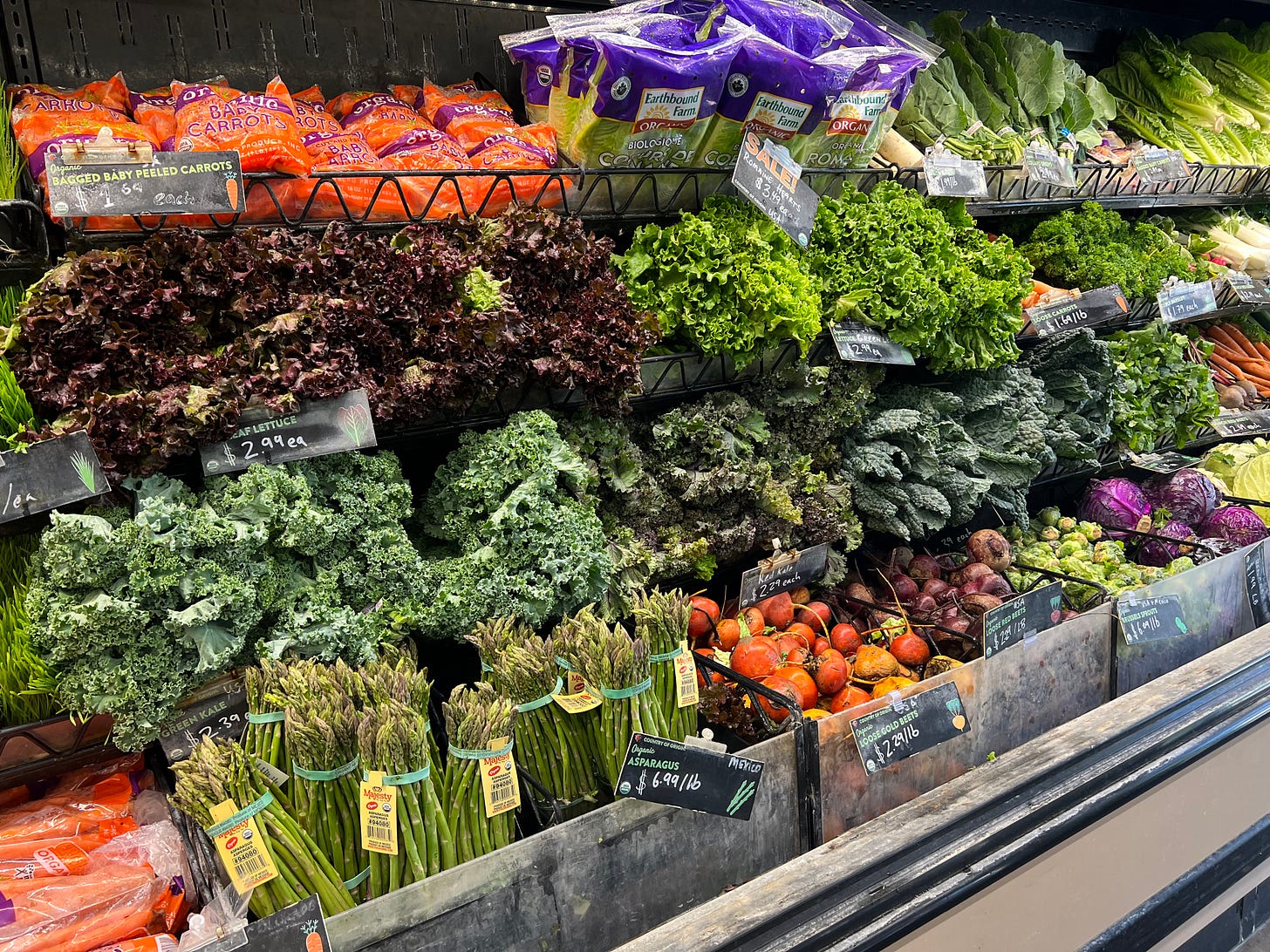
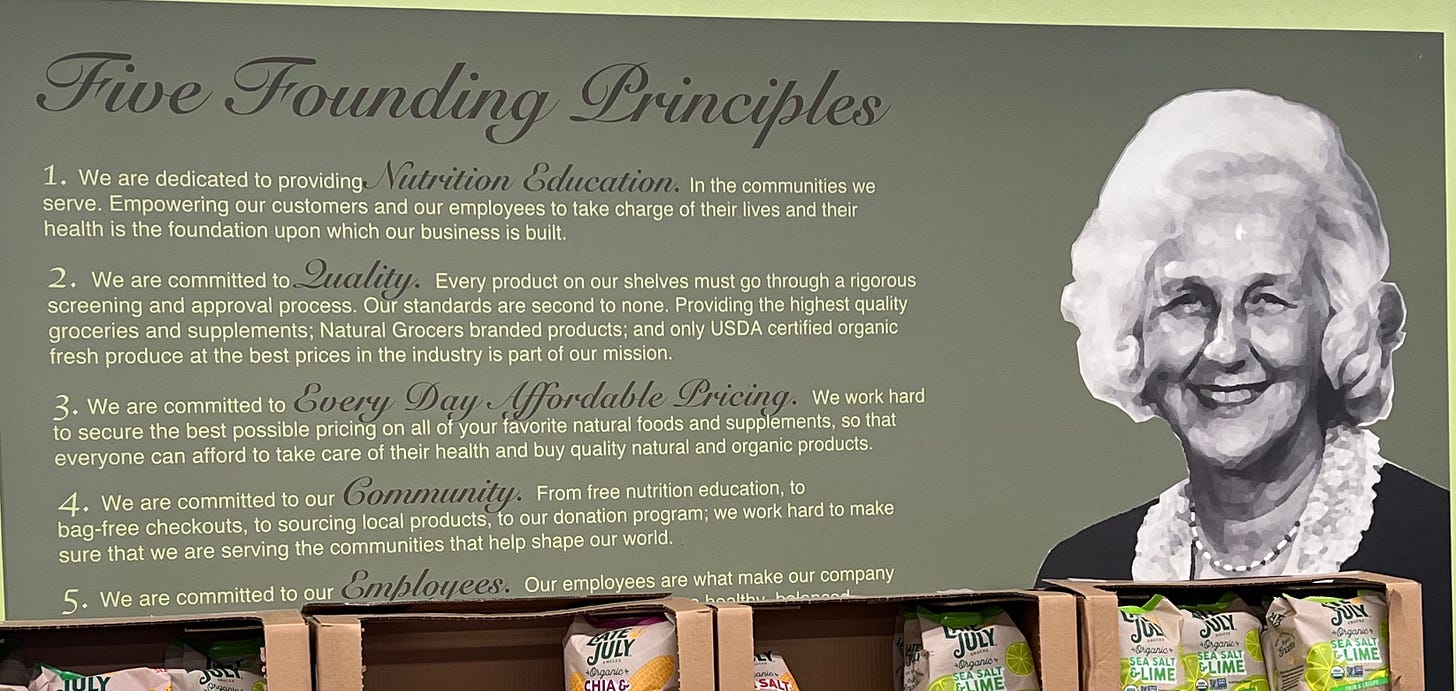
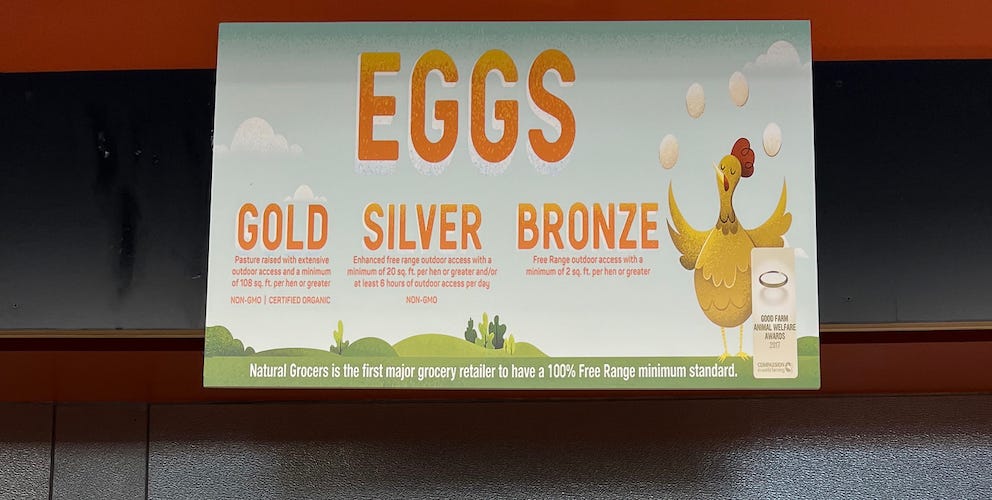
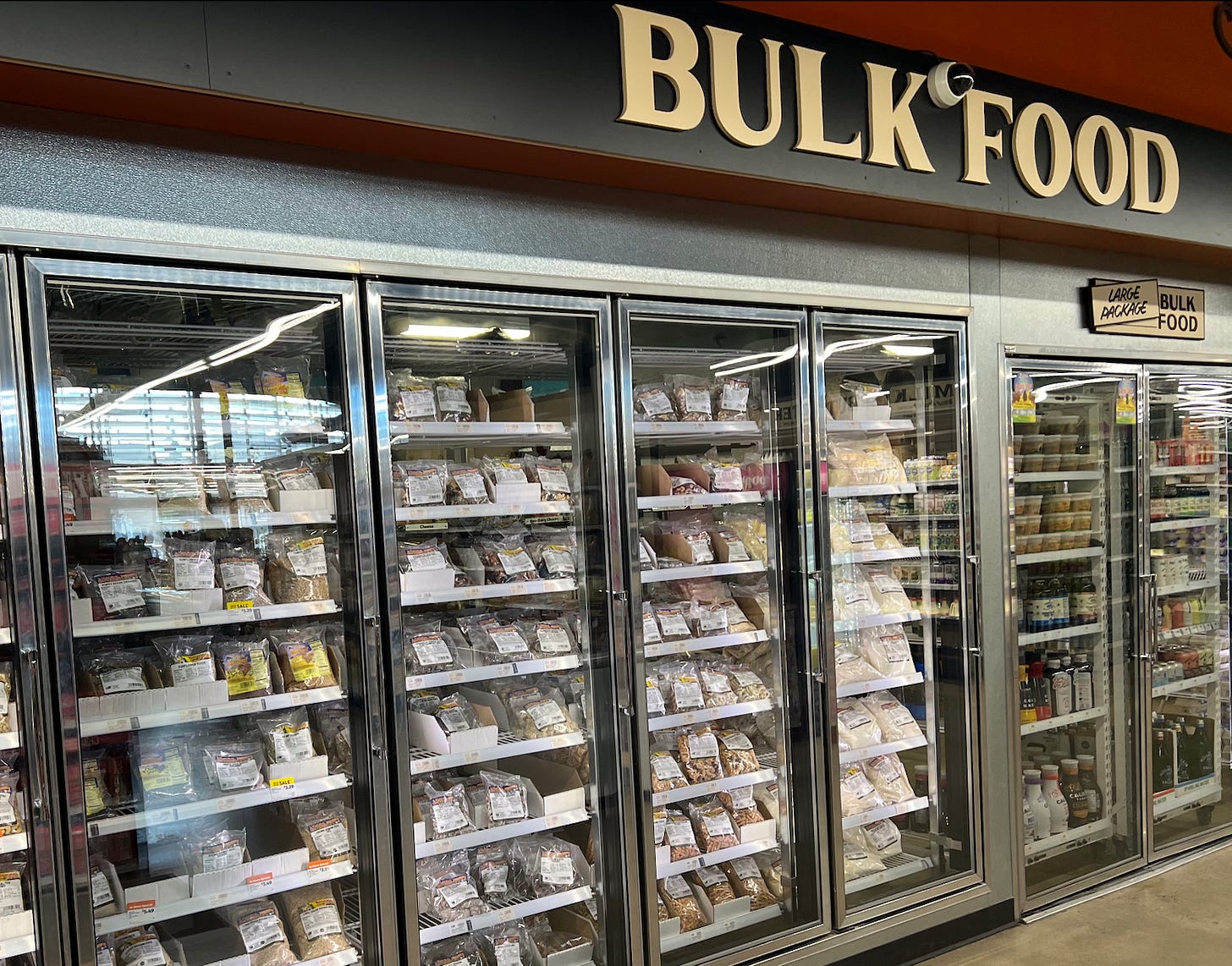
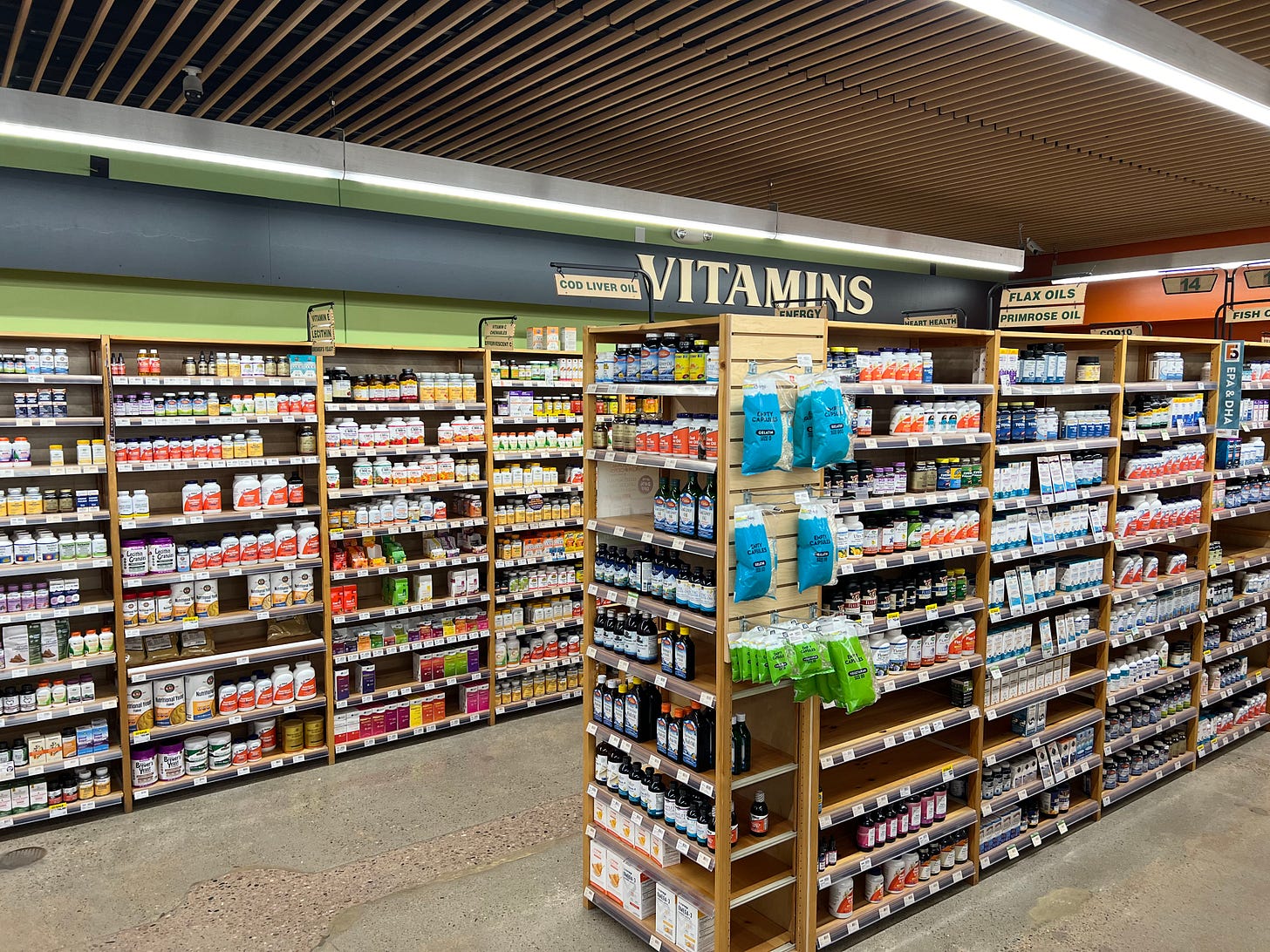
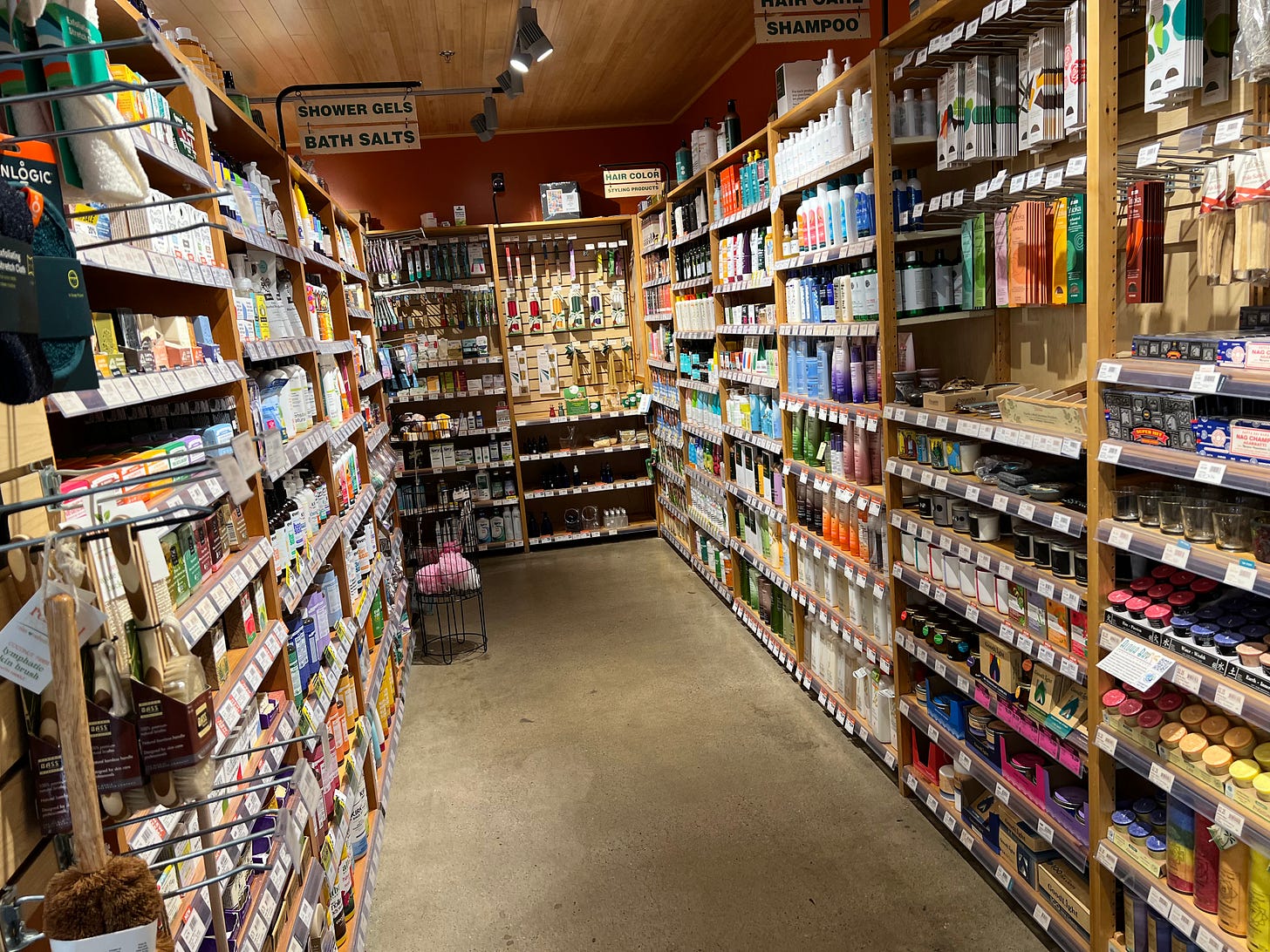

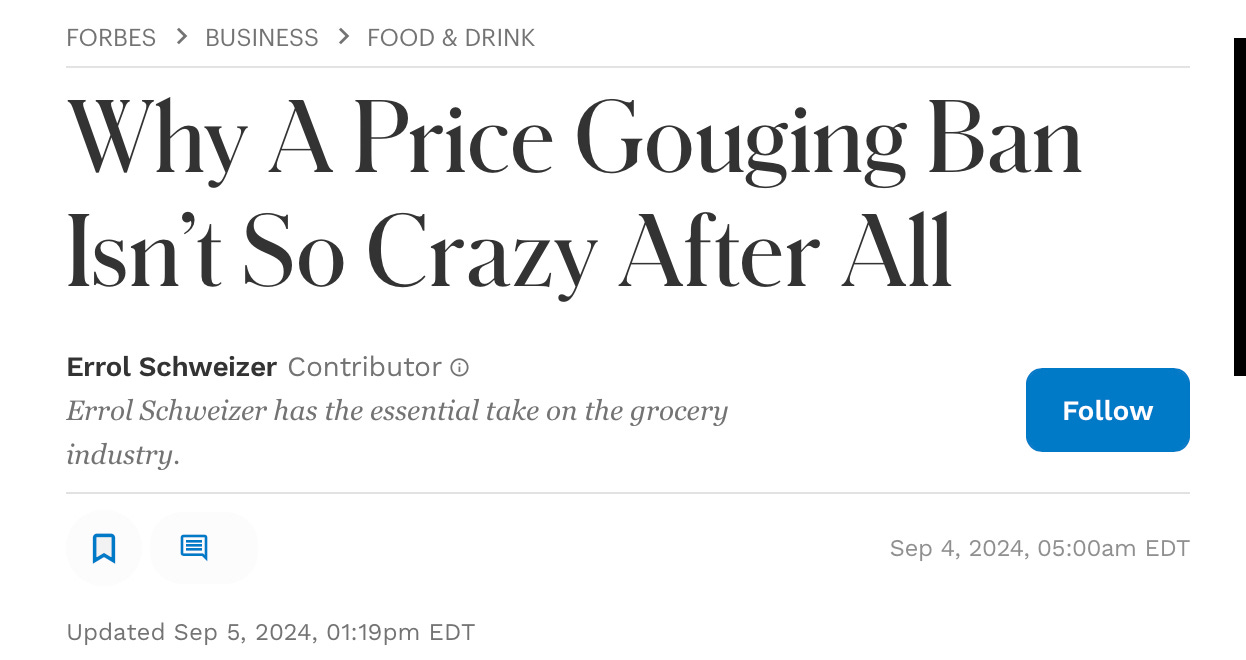
I got verklempt reading this. When I opened New City Market in Chicago in the 80s, we were exactly this. 50% Supplements that took up 25% of the space due to dollar density of the merchandise. We had a nutritionist on staff to sell and counsel people, and we ‘paid the rent’ with supplement sales so we could be 100% virtuous in the grocery aisles, subsidized, really. We had picked the right neighborhood and we knew it. So did Whole Foods Market who came to town 2 blocks away and then bought up the Fresh Fields stores and I knew we were toast. I left to join the vendor side of the industry and my prior business partner lasted a few more years but WFM eroded the customer base and the store went under. I’m so glad NGVC is still doing this, though I wish there was one near me. On the bright side, after 10 years of trying, the Wild Onion Co-op opened a few months ago 2 blocks from my house. So full circle, back shopping small format and I hope the Co-op succeeds. Chicago has never been a co-op town; maybe we’ll get lucky this time.
I couldnt agree more with your take on Natural Grocers, Errol. They have been a great fit for Equal Exchange bulk coffee and they work with Cornucopia Institute to carry their OG scorecards for shoppers who want to do more research on the brands they carry. Still independent and family owned at their scale. Because they are publicly traded you can access their financials and management reports. They make hard decisions to close a few stores as they open new locations and appear to (gasp!) invest back in the business instead of stock buy backs! it is the 70s! thank goodness they are here to remind us of how the grocery business can still be.